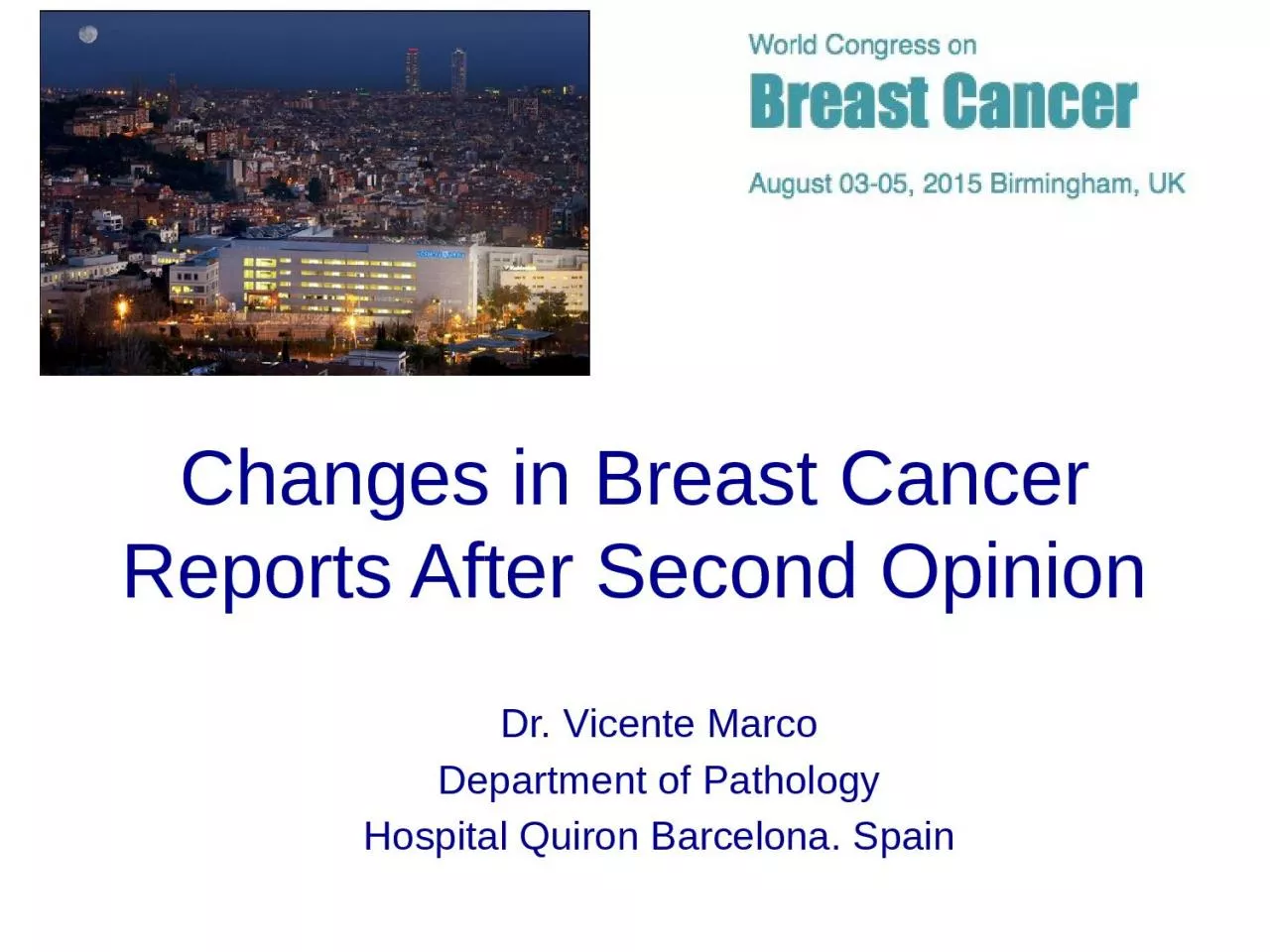

Dr Vicente Marco Department of Pathology Hospital Quiron Barcelona Spain Second Opinion in Breast Pathology Usually requested when a patient is referred from another institution for treatment ID: 1041583
Download Presentation The PPT/PDF document "Changes in Breast Cancer Reports After S..." is the property of its rightful owner. Permission is granted to download and print the materials on this web site for personal, non-commercial use only, and to display it on your personal computer provided you do not modify the materials and that you retain all copyright notices contained in the materials. By downloading content from our website, you accept the terms of this agreement.
1. Changes in Breast Cancer Reports After Second OpinionDr. Vicente MarcoDepartment of PathologyHospital Quiron Barcelona. Spain
2. Second Opinion in Breast PathologyUsually requested when a patient is referred from another institution for treatmentAn opportunity to detect diagnostic errors that impact on patient management.
3. Who’s requesting a second opinion in Breast Cancer ?Medical OncologistsBreast SurgeonsPatientsPathologists
4. Prognostic Factors in Breast Cancer Tumor sizeTumor gradeHistological typeMargins of resection Lymphovascular invasionProliferative IndexLymph node stagePredictive markersEstrogen & progesterone receptorsHER2
5. Breast cancer management team effortPathologistsSurgeonsOncologists“Castellers in Catalunya, Spain”
6. Questions for the pathologist when providing a second opinion in breast biopsiesIs it cancer?Is it breast cancer?Is it invasive breast cancer?Are the margins of resection free of disease?Are the predictive markers of response accurate (Hormone Receptors, HER2)?
7. Special situationsPatient with previous history of breast cancer presenting with disease in other organs.Patient with history of non-breast cancer presenting a breast lesion. Tumor presenting in the axilla without a clinically evident breast lesion.
8. Tumors of the axillary regionMetastatic tumors to axillary lymph nodes.Metastases from occult breast cancerPrimary tumors of the axillaBreast cancer arising in ectopic breast tissuePrimary tumors of skin appendages
9.
10. Concordance among pathologists in the diagnosis of breast lesionsBenign lesions without atypiaAtypical HyperplasiaDuctal Carcinoma in situInvasive cancer
11. Diagnostic concordance among pathologists interpreting breast biopsy specimensDiagnosisConcordance rateOverinterpretationrateUnderinterpretationrateBenign without atypia87% (85-89)13% (11-15)Atypia48% (44-52)17% (15-21)35% (31-39)DCIS84% (82-86) 3% (2-4)13% (12-15)Invasive carcinoma96% (94-97) 4% (3-6)Modified after Elmore JG et al. JAMA 2015;313 (11):1122-1132.
12. Why do pathologists disagree in the diagnosis of breast lesions?Different levels of training and experienceDifferent levels of interest in breast pathologyInterpretation of borderline or grey zone casesDiagnosis of rare casesSpecial clinical situationsTechnical issues
13. Classification of second opinion results in breast pathologyConcordantMajor discrepanciesPotential for significant change in prognosis and/or treatment.Minor discrepanciesDon’t impact significantly in prognosis and/or treatment.
14. Rate of major discrepancies in breast cancer pathology after reviewAuthor/ yearNumber of cases reviewedMajor discrepancies %Staradub et al. 2002 340 7.8Newman et al. 2006 149 9Price et al. 2010 93 11Kennecke et al. 2012 405 6Middleton et al. 2014 2718 6.20Marco et al. 2014 205 16Romanoff et al. 2014 430 10Khazai et al. 2015 1970 11.47
15. Second Opinion in Breast PathologyMajor Discrepancies Changes in Histologic Diagnoses (37.7%)Invasive Carcinoma vs DCIS (32 %)Invasive Ca DCISDCIS Invasive CaHormone Receptors Results (9.4%)ER- ER+HER2 Results (20.7%)HER2+ HER2 -
16. Second Opinion in Breast Pathology Major Discrepancies in 46 PatientsFirst DiagnosisSecond OpinionNInvasive breast cancerLung cancer metastasis to lymph nodeLung cancer metastasis to breastFibroadenoma/DCIS/ Lobular neoplasiaAtypical ductal hyperplasiaAtypical papilloma/DCISChanges in histologic type of primary breast tumor (phyllodes tumor, adenoid cystic ca, atypical vascular lesion, fibromatosis)Invasive carcinoma NSTDCIS with microinvasionDCIS Estrogen receptor negativeEstrogen receptor positiveHER2 positiveHER2 negativeBenignLung cancer in breast, brain and lymph nodesCutaneous axillary adnexal carcinomaAxillary metastasis of melanomaBreast cancer metastasis to lymph nodePrimary breast cancer, small cell typeFibroadenoma/Lobular neoplasiaDCIS high gradePapilloma with ductal hyperplasiaSpindle cell ca, cribriform ca, angiosarcoma, myofibroblastic sarcomaDCISDCIS with microinvasionDCISDCIS with invasive carcinomaEstrogen receptor positiveEstrogen receptor negativeHER2 negativeHER2 positive4421111114922441101
17. 30 y-o woman with axillary mass.First diagnosis:Consistent with breast cancer metastasis.
18. Second opinion: Metastatic adenocarcinoma of lungTTF-1NAPSIN A
19. Immunohistochemistry in the differential diagnosis of lung and breast cancerLung CancerBreast CancerTTF-1+-Mammaglobin-+p63+-ER-+GATA-3-+
20. Assessment of predictive factors of response in Breast CancerHormone Receptors:Estrogen ReceptorsProgesterone ReceptorsHER2ImmunohistochemistryIn situ hybridization
21. Assessment of predictive factors of response in Breast CancerTechnical IssuesFixationMethodologyInterpretative Issues
22. Estrogen ReceptorsAssessment by ImmunohistochemistryNIH Consensus 2001 “….patients with any extent of hormone receptors in their tumor cells may still benefit from hormonal therapy”Dichotomous results99% of tumors are negative (0%) or positive in 70% or more of cells.1% cutoff for ER positivityFalse negative ER is more problematic
23. Estrogen Receptor IHCNEGATIVE POSITIVE LOW POSITIVE HIGH
24. HER2 AssessmentASCO-CAP Guidelines
25. HER2 SCORE IHC
26. HER2 IHC SCORE2+3+
27. HER2 ISH Assay
28. HER2 ISHNegative. Ratio<2Positive. Ratio >2
29. CONCLUSIONSMajor discrepancies in the evaluation of breast cancer reports are often related to the assessment of the degree of invasion of breast carcinoma and the immunohistochemical results of predictive markers, in particular HER2.The assessment of axillary lesions and distant metastasis in patients suspected of having breast cancer or with a history of treated breast cancer may reveal non-mammary tumors.
30. ConclusionsSignificant improvement in the concordance among pathologists in the assessment of breast lesions can be achieved by careful histological study, following standardized criteria, and having complete clinical information.Using high quality IHC techniques will improve the evaluation of markers of prognosis and therapeutic response.
31. Thank you